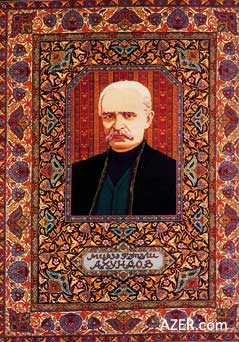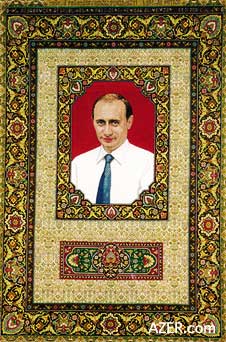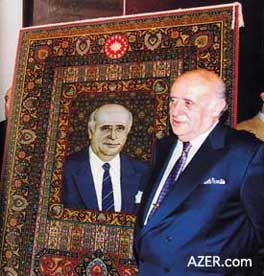|

Autumn 2002 (10.3)
Pages
64-67
Millions of Threads
The Portrait
Carpets of Kamil Aliyev
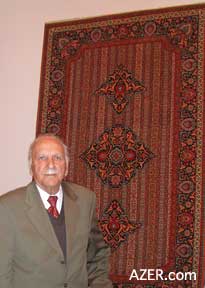  Sooner or later, we all face a common
gift-giving dilemma: what do you give to the person who already
has everything? No doubt, presidents face this dilemma more often
than many of the rest of us, certainly every time they make official
state visits to meet other world leaders. In many cases, President
Aliyev turns to a personalized memento that vividly and unmistakenly
represents Azerbaijan - a portrait carpet. Sooner or later, we all face a common
gift-giving dilemma: what do you give to the person who already
has everything? No doubt, presidents face this dilemma more often
than many of the rest of us, certainly every time they make official
state visits to meet other world leaders. In many cases, President
Aliyev turns to a personalized memento that vividly and unmistakenly
represents Azerbaijan - a portrait carpet.
Left: Kamil Aliyev in his office at the AzerCarpet
Production Creation Union.
Artist Kamil Aliyev (1921- ), director of the AzerCarpet Production
Creation Union, has been designing and crafting portrait carpets
for nearly 45 years. He has created portraits of dozens of public
figures, including former U.S. President Bill Clinton, Russian
President Vladimir Putin, Turkish President Demirel, and India's
Indira Gandhi. Each portrait's elaborate ornaments - birds, flowers
or more abstract designs - are usually based on traditional Azerbaijani
carpet motifs.
"This is pure Azerbaijani art," Kamil says about his
carpets. "The designs reflect a precious heritage that goes
back hundreds of years." Here he explains the complicated,
painstaking process that goes into creating these one-of-a-kind
carpet portraits.
______
Weaving a portrait carpet is
very difficult. With about a million threads to keep track of,
it can be tricky to get the features of the face correct and
still suggest the personality of the person. It's especially
difficult to get the eyes just right. On the other hand, it's
relatively easy to make portraits of people who lived hundreds
of years ago because no one knows what they really looked like.
Being able to look at thousands and thousands of threads takes
an enormous amount of concentration and patience. The color,
composition and weaving of the ornaments must all be correct.
If every ornament is woven correctly, then the carpet will be
beautiful in itself.
Early Start
I think I was always interested in carpet weaving. At first,
I learned about weaving carpets from my mother and my grandmother.
At that time, there wasn't a carpet faculty at the Artists' Technical
School, although there was a general artist's faculty. So in
1938, while I was studying in the Technical School, I began working
as an artist at the Azerkhalcha Istehsalat Yaradijiliq Birliyi
(AzerCarpet Production Creation Union) in order to learn more
about carpet art.
Above: (from left to right) 14th-century Azerbaijani
poet Nasimi, Vladimir Lenin who led the Bolshevik Revolution
that resulted in the establishment of the USSR, writer, reformer
and playwright Mirza Fatali Akhundov (1812-1878), Former Prime
Minister of India Indira Gandhi, President Heydar Aliyev, Russian
President Vladimir Putin.
I worked there for three years, and then I was sent off to fight
in World War II. I didn't return until 1946, after being stationed
with the Soviet occupying troops in Berlin. During the war, we
didn't fight for Azerbaijan or Ukraine or any other country.
We fought for the USSR, which we considered to be our Motherland.
We were told that fascism was a "disease" that could
infect the entire world. It was so difficult to fight in the
war for six years; I was wounded several times. So many of our
guys didn't make it home.
After returning home from the war, I starting working at one
of the art studios. I gained a lot of experience there and learned
how to make portraits. Whatever I drew seemed to turn out well.
Before I went to the war, I was only familiar with carpet art-I
didn't know how to make portraits. But soon I became the only
specialist in Azerbaijan who could draw portraits and who knew
the technology of weaving carpets.
Above: (left) Carpet portrait of President
Bill Clinton and First Lady Hilary Clinton woven as a gift on
the occasion of President Aliyev's official visit to the United
States in 1997.
Right: Turkish President Demirel.
I didn't go to school to learn about carpet - my school was the
great carpet master Latif Karimov (1906-1991). He was like a
fount of Azerbaijani carpet culture. Karimov was from Iran and
came to Azerbaijan in the 1930s. He wrote several books on carpets,
classifying them into 144 different categories and separating
the designs of Azerbaijani, Georgian and Armenian carpets according
to their motifs [Ganja-Kazakh, Guba-Shirvan, Karabakh, and Tabriz
typologies]. My first portrait carpet was the one I did of the
poet Fuzuli in 1958 to commemorate his 400th Jubilee. I got the
idea after seeing some of the older Iranian carpets that featured
portraits of shahs. I chose Fuzuli because he was a famous, respected
poet throughout the Islamic and Turkish world. I also liked the
fact that all of his ghazals [a type of Eastern poem] are about
love and beauty. He considered love to be the most valuable gift
or blessing for the people of the world. With this in mind, I
decided to portray Fuzuli with flowers and nightingales. I've
created dozens of other carpet portraits since then. Some of
them are of writers, such as Nizami [12th-century poet], Nasimi
[14th-century poet], Mirza Fatali Akhundov [19th-century Azerbaijani
writer and alphabet reformer], Pushkin [Russian poet], and Shota
Rustaveli [Georgian writer]. I also did portraits of various
Soviet leaders, including Khrushchev, Brezhnev and Putin.
In 1987, I held an exhibition in India. There's a big carpet
school in India, so I wanted to show them our carpet weaving
technology, the traditions we have in Azerbaijan and the beauty
of our carpets. I did this by creating portraits of their famous
people, such as Indira Gandhi and Rabindranath Tagore [Indian
writer, winner of the 1913 Nobel Prize for Literature]. When
I took those carpets to India, the people waited in long queues
to see the portraits.
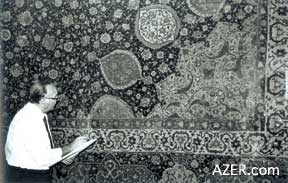  I've also made several carpets of Heydar
Aliyev, including the one for his 75th Jubilee in 1997. Right
now I'm starting to design the one for his 80th Jubilee, which
will take place in May 2003. I've also made several carpets of Heydar
Aliyev, including the one for his 75th Jubilee in 1997. Right
now I'm starting to design the one for his 80th Jubilee, which
will take place in May 2003.
Left: Kamil in London viewing the famous
gigantic Shah Safi carpet (1539-1541) on display at the Victoria
and Albert Museum which covers an entire wall (10.97 x 5.37 meters).
The Shah Safi carpet (or what has become known as the Ardabil
Carpet) is based on the Tabriz school of carpet weaving, and
is considered to be one of the finest in the world.
Another carpet shows Bill Clinton and his wife, Hilary; it is
the only such double portrait carpet among all my works. In 1997,
Heydar Aliyev asked me to find a way to create a carpet with
both of their portraits. Actually, we created this carpet before
the Monica Lewinsky scandal broke out. President Aliyev wanted
to present it as a gift during his official visit to the United
States in 1997. After a lot of thought, I decided to put both
of their portraits inside a heart. [Read more at "State
Visits, State Gifts: Memorializing the Clintons in Carpets"
in AI
5.3 (Autumn 1997).]
The first stage in preparing any portrait carpet is to come up
with the design. To do this, I prepare a sketch that designates
all of the technical features, such as the thickness, number
and color of the loops as well as the length and width of the
full carpet. After the sketch is ready, it has to be enlarged
to match the size of the carpet.
Everything has to make a cohesive whole: the choice of colors,
the ornaments, the person's clothes, the face, everything. For
instance, when I did Ataturk's portrait, I noticed that his other
portraits showed him wearing a khaki uniform, but that reminded
me of German uniforms in the war. I didn't want him to look like
that, so I put him in a white uniform.
Above Left: Study for portrait of Fuzuli
Right: Carpet portrait of Azerbaijani poet
Fuzuli, created on the occasion of his 400th Jubilee (1958)
Next, I transfer the features shown in the sketch into technical
loops, including details like the eyes, eyebrows and hair. Every
loop has its own color. I choose these threads and colors according
to the sketch that I have made. In fact, I even dye the wool
myself. Otherwise, I can't get the exact color that I want.
Usually, I don't physically do the weaving myself but I sit next
to the carpet makers to make sure they're doing everything right.
If there's a mistake, the weavers must go back, undo the knots
and weave the pattern again. Also, by being involved while the
carpet is being woven, if I don't like the color of a certain
loop, I can easily change it. Depending on the width of the carpet,
there may be three, five or even seven people engaged in the
weaving process. However, only one person is assigned to do the
actual portrait. In the face, there are 50-60 colored loops to
keep track of, so only the person who began the process can continue
it.
One of the greatest difficulties in making carpets in Azerbaijan
today is the sales tax that the government imposes. We have trouble
selling our carpets because they are very expensive. We have
to charge 18 percent tax on each one. Meanwhile, the Pakistanis
copy our patterns and sell their carpets at half the price. They
don't have to pay tax on carpets there. This is why it's so difficult
for a carpet maker to make a decent salary in Azerbaijan.
I've enjoyed my life's work but I'm afraid that after me, the
tradition of making these portrait carpets will die. It seems
there is no one in Azerbaijan right now who can carry on my legacy.
Today's youth who graduate from the carpet institute aren't trained
to draw portraits.
After all, it's very difficult to be a carpet artist. You have
to look at thousands of loops, one by one, which can be very
damaging to the eyes. Not every person has the patience for this
kind of work. In my opinion, it's not possible to develop into
a good carpet artist. This talent is a gift from God that is
bestowed upon a chosen few.
____
Back to Index
AI 10.3 (Autumn 2002)
AI Home
| Search | Magazine
Choice
| Topics
| AI Store | Contact us
Other Web sites
created by Azerbaijan International
AZgallery.org | AZERI.org | HAJIBEYOV.com
|




